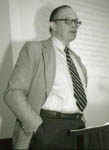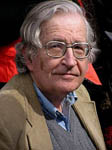Main Content
Lesson 1 : History and Research Methods
Cognitive Revolution
The cognitive revolution grew out of a rejection of the assumptions of behaviorism. Behaviorists, remember, proposed that it is not necessary to study mental events while describing behavior. The focus of behaviorists was the study of the environment and behavior. They considered the mind as a sort of "black box"—things happen inside the box, but we don’t care (and don't need to know) what goes on inside. Instead, during the late 1940s and early 1950s, researchers realized that any explanation of human behavior and abilities must include an examination of how people mentally represent the world around them. This idea formed the basis for the cognitive revolution.
 Figure 1.12. Miller, Author: Unknown, commons.wikimedia.org
Figure 1.12. Miller, Author: Unknown, commons.wikimedia.org
The historical context of the era played a role in the development and expansion of cognitive psychology (although the term "cognitive psychology" wasn’t coined until 1967 by Ulric Neisser). During World War II, human factors engineering was a field that grew rapidly. Technology quickly developed, and personnel had to be trained to use the equipment efficiently and effectively. Equipment started to be designed with the user in mind, both in terms of physical and mental abilities. Psychologists were intimately involved in the design process, and after the war ended, many of them returned to their roots as psychologists. But during the war, they had been exposed to different ways of thinking about information. They discovered that humans were processors of information, much like a computer (we’ll get to that idea in a second), with limits on the amount of information that we can process.
Researchers started to study the limits of this capacity to process information and laid the groundwork for the birth of cognitive psychology. Thus started the cognitive revolution in the 1950s. George Miller (1956) authored one of the most famous psychology papers that looked at methods to study the capacity of processing capabilities. Miller examined how many distinct things we can perceive without counting and the number of unrelated things that we can recall immediately (somewhere between 5 and 9 with an average of 7). The research was instrumental in demonstrating how cognitive processes (and their limits) could be studied and measured.
 Figure 1.13. Chomsky, Author: Duncan Rawlinson commons.wikimedia.org
Figure 1.13. Chomsky, Author: Duncan Rawlinson commons.wikimedia.org
Around the same time as Miller, Noam Chomsky revolutionized the field of linguistics. Chomsky was a strong and vocal critic of B.F. Skinner and behaviorism in general. His interests lied in the acquisition, understanding, and production of language, and he felt that behaviorism was not able to offer a sufficient explanation. In his early work, he demonstrated that behaviorism cannot explain how language is used by humans (Chomsky, 1959, 1965). In particular, he looked at the grammar mistakes children make (you have probably heard many of them before: “I ranned,” “He goed,” “Look at the deers,” etc.). Behaviorism required reinforcement for learning to occur, but children certainly aren’t reinforced for these utterances (although they are cute). Instead, Chomsky proposed that our acquisition, understanding, and usage of language are related to the way the mind is constructed, particularly in the way we represent information.
Taken together, these studies demonstrated the need to look beyond behavior. The mind was slowly being brought back into the picture of mainstream psychology (at least in the United States). But there was another development that greatly influenced the rise of cognitive psychology—the digital computer.
